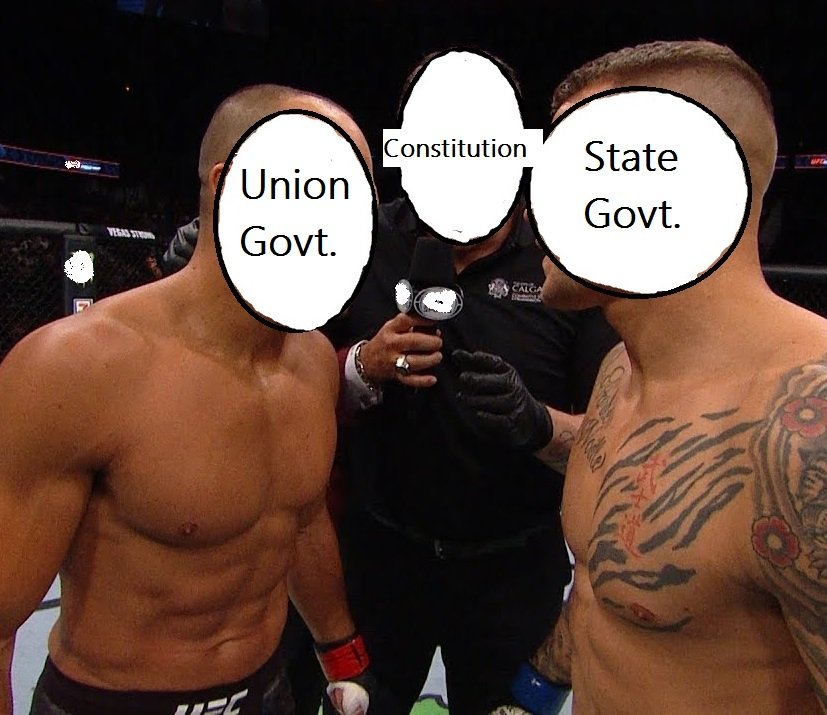The Constitution of India provides a federal system of government in the country even though it describes India as ‘a union of states’. The term implies that firstly, the Indian federation is not the result of an agreement between independent units, and secondly, the units of Indian federation cannot leave the federation.
Table of Contents
What is Indian Federalism and tell us more about the centre-state relationship?
The Indian Constitution contains both federal and non-federal features.
Meaning of Federal Government:
It often refers to a system of parallel government where the powers of administration are categorised into two levels.
1. Central or federal level
2. State or local level
The basic funtion of any government is to control and administer the life of its public, the division of these powers into two hands namely the central and state as in the case of India helps in proper governance and draws a distinct line between the areas of center and state.
What are the features of Indian Federalism?
The Constitution of India is the supreme law of the land and it clearly outlines the two levels of government, their powers declaring it be a ‘Union of states’.
Part XI of the Indian constitution specifies the distribution of legislative, administrative and executive powers between the union government and the States of India.
The supreme court of India is said to be the ‘Check authority‘ and it has been given independent powers to review and settle disputes that may arise between these levels.
The fundamental provisions of the governments that are enshrined in the Constitution of India cannot be altered by any one level of government.
So, wait. Do you mean India has a federal form of government?
Well, It is one way of saying it. But in its strict sense, while our constitution was being drafted a lot of research must have gone through different forms of government that India should adopt. Finally, maybe after analysing on these various fronts the makers of the Constitution came up with the idea of a hybrid style government. It has mostly federal features but at times can turn into a unitary form of government,
For example, during the Emergency the powers of the various states are paralysed and the Union government or the central government takes over. Although it is known that the President declares the emergency in the rarest of rare cases.
However, not just these, we also happen to have single citizenship unlike in the case of united States of America where citizens are subjected to dual citizenship. Apart from these we are also subjected to an Independent system of Judiciary.
Here’s why I wouldn’t consider India to be a federation:
- If you have read the provisions of the Constitution carefully, the Centre is in many aspects stronger than the State government.
- Even if we have two levels of government and we could say they’re independent of each other, we cannot deny that both are governed by the single constitution.
- The Rights of the Central government to make laws on state subjects on the recommendation of the Rajya Sabha.
- The Residuary powers are granted to the Central government and not the state.
On account of this differences, we can consider India to be quasi-federal in nature.
What do you think about Centre-State relationship?
Any country having multiple sets or levels of government must have a way of administration that helps co-ordinates amongst themselves. The Centre-State relationship has been defined by various provisions in the Constitution of India.
Basically, these can be divided into three heads namely the (i) Legislative relations (ii) Administrative relations (iii) Financial relations.

Legislative Relations:
The Constitution of India divides the legislative relations between the union and the states viz. three lists. These lists contain the subjects on which the respective government can make laws.
1. The Union List or the List I: Contains 97 numbered items on which only the union or the central government can make laws. These include defense, foreign matters, posts, and telegraph, etc
2. The State List or the List II: Contains 66 numbered items on which the respective state government can make laws, These Include Police, administration of justice, prison, local government, agriculture and etc.
3. The concurrent List or the List III: Contains 47 numbered items on which both the centre and the state can make laws, However, If ever there’s a clash on legislation, the central law shall prevail over that state law. This list includes matters like Education, population control, books, marriage and divorce and etc.
Human lives are so complicated that not all can list the problems or subject areas that can arise in the future. All the other subjects that are not covered in these three lists are often referred to as the residuary list and the union has the sole power to make laws on them.
Can parliament make laws on the subjects that are contained in List II or the State List?
Yes, sometimes though. When the Rajya Sabha passes a resolution by at least two-third majority asking the parliament to legislate on a subject of state list, the parliament can do so. If in relation to an implementation of an international treaty it is required for the parliament to legislate on state subjects then it may do so too.
Also, the President of India can make laws in the form of the ordinance during the emergency. however, as you must know, Ordinance is only temporary law in force.
Administrative Relations:
The Indian Constitution is based on the principle that Executive power is co-extensive with Legislative power. The Union Executive i.e the President of India or the State Executive that is the respective governors can legislate with all the matters that the union or the state can legislate.
The Executive power over the subjects on the concurrent list or the List III is also exercised by the states unless the union decides so. The centre often issues directives to the state to ensure compliance with the laws as and when require and in failure to do so the parliament having the supreme power of legislation can overrule the state law.
The centre also acquires control over the states through All India Services, grants-in-aid, and the parliament can alone adjudicate the matters relating to river disputes amongst the states.
During the proclaimanation of emergencry or failure of constitutional emergency, the parliament assumes power of the state executive.
Fianancial Relations:
Have you ever wondered who takes our taxes? the union government or the state?
Both the union and the state have been provided independent sources of revenue by the Constitution of India. The parliament can levy taxes on subjects mentioned in the union list and the state on the subject of state lists. Ordinarily, the List III or the concurrent list has no subjects on which taxes can be levied. (You don’t want them to fight, do you?)
So, In respect to financial standing also the center has overwhelming power over the states. The state governments are kept under control viz different machinery of the constitution such as Comptroller and Auditor General of India (C&AG) and financial grants.
During the emergency, the president can also pause the distribution of funds between the centre and the state.
So, Who’s the tough guy, huh? I’ll let you decide,

Passionate about using the law to make a difference in people’s lives. An Advocate by profession.




